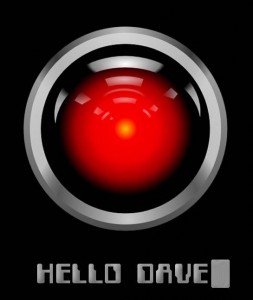The ultimate GUI is: no GUI at all
 TL;DR version: We thought touch interfaces would finally bring computers to everyone, but in reality even that requires too much training. People don’t bother to learn. The only interface that will make computers truly universal is an AI you can talk to.
TL;DR version: We thought touch interfaces would finally bring computers to everyone, but in reality even that requires too much training. People don’t bother to learn. The only interface that will make computers truly universal is an AI you can talk to.
Or: Your mom won’t learn how to use an iPad, just like she didn’t learn how to use a VCR.
We’ve always known that normal people can’t use computers, not really. But this week end it occurred to me that they don’t really know how to use tablets either. Sure, they do email (if you set it up for them) and browse a bit, but ask them to connect to WiFi or subscribe to a newspaper through an App, and they’re lost. And same as computers, they will never learn.
It comes from this ridiculous article: a “comprehensive” study on 16 people (sic) showed they can’t use iPad apps. The study is silly, but the conclusions are true: no matter how simple you make it, a graphical interface will never be easy enough that you can use it with no training at all. It’s still a theoretical, abstract representation of what you want the machine to do. Even with iOS, which is so simple it’s ridiculous, you have to explain to your mom how to go to the app store, or how to connect to the WiFi network, or how to get the family pictures on there. Millions of people use and love their iPads, but “millions” is not “everyone”.
When tablets first appeared, some thought that a super simplified GUI with such a minimal learning curve would probably mean that everyone (and their mother) would be able to use it. I was one of those. It requires so little effort to understand, surely it could work, right? Good bye windows metaphor woes, file systems, complicated updates and installations! Surely this machine is dumb enough that everyone can use it.
And it is indeed more accessible than full blown PCs, but the truth is that even the “minimal effort” required is too much effort when you don’t really care. The real problem is that the process of learning how to use it is still there. It seems trivial to us, but we’ve been “training” on PCs for years. And it’s not a matter of “getting used to it” either: computers have been around for decades, and most still don’t know the first thing about them. Hell, programming a VCR remained near impossible for your parents, right?
But you know what doesn’t require training? Asking someone to do it for you.
And that’s the sad truth: no matter how simple you make the GUI, it won’t work for normal people. Until they can ask for stuff and have it happen, computers won’t be for everyone. What we need a sort of “Audio User Interface”. And what do we need for that? Simple! Near perfect voice recognition, and mind blowing artificial intelligence.
Sure you’ll still navigate a page with your finger, but most things should be doable by just asking for it. “I just landed abroad, stop using data stuff that costs extra”, “Hey, show me the pictures of my kids from the trip to Milan last year”, “did I get that reply from John?”
Voice commands aren’t there yet, and we probably won’t be for a few years still (if not decades). There will be a few clumsy tries that we’ll all laugh at, and then they’ll get better, and then everyone will freak out because their toasters is making jokes so that must mean they have feelings that shouldn’t be hurt. I’m looking forward to that.
But until then, even a magical iPad with its ultra controlled user experience won’t cut it for everyone. Don’t get me wrong, they’re simpler than PCs, and they are certainly a good step in the right direction of “universalizing” computers. But in my humble opinion this isn’t a universal solution yet, and it won’t be next year, or the year after that. And as long as we need a Graphical User Interface, computers won’t be for everyone…
So there you have it: the truly universal GUI is to get rid of it all together.

